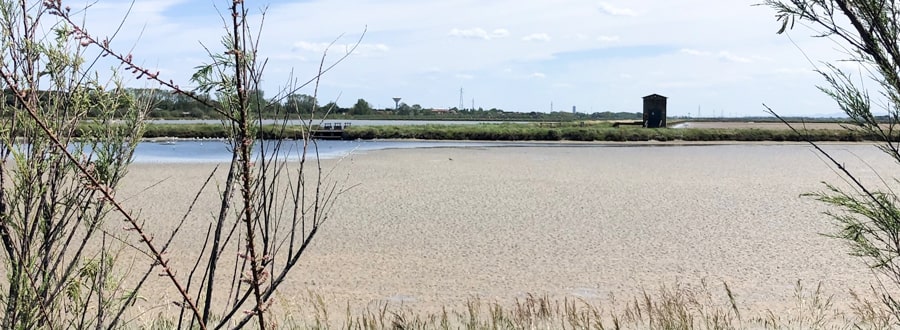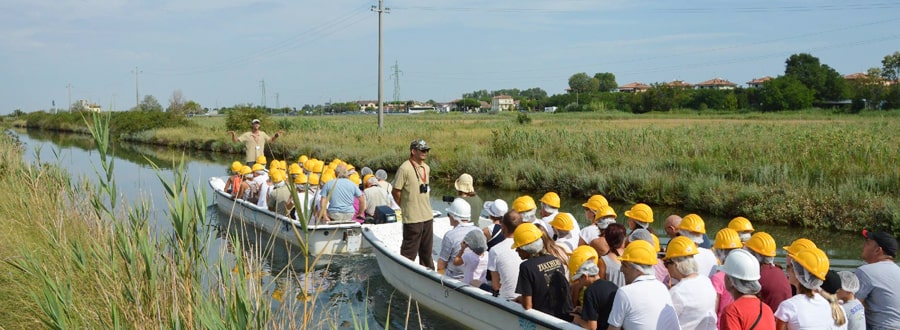Salina
History of Cervia Salt
Salt accompanies the history of Cervia from its origins.
Already in Etruscan times, the activity of processing and producing salt was central to the life and development of the small city. An essential element in food and its preservation. Also called "white gold," Cervia's salt is characterized by being "sweet" compared to other types of sea salt, thanks to the climate conditions and the particular technique of daily collection that prevents the formation of the bitterest crystals.
Its extraction was central to the territory's economy and a source of rich trade in Roman times, continuing also in the Middle Ages and up to the present day.
In 1959, the history of the Cervia salt pan took a turn: the property passed into the hands of the State Monopolies, and the manual collection method was completely replaced by an industrial method that only allowed for annual collection. This continued until 1998 when a series of events led to the closure of the salt pan after two thousand years of activity.
Since 2003, thanks to the Municipality of Cervia and the Management Company of the Cervia Salt Park, the salt pan has resumed its activity and, even though today extraction is done with mechanical methods, the unique "sweetness" characteristic of this special salt has been preserved.
Of the many basins of the salt pan, one remains, the Salina Camillone, where salt is still collected manually and artisanally, according to the "Cervese" method. This basin is entrusted to the Cultural Group Association Civiltà Salinara of Cervia, and it is possible to visit it to experience the life of salt workers of the past.
The sweet salt of Cervia was recognized as a Slow Food Presidium in 2004, for its quality and cultural and historical value, making Cervia the quintessential City of Salt.
Due to the 2023 flood in Romagna, the Cervia Salt Pan is currently not operational. Reopening on 29 March 2024.
MUSA Salt Museum
To learn about the history of the Cervia Salt Pan, the life of the salt workers, and their hard work, you can visit the Salt Museum, located in the historic center of Cervia at the Magazzi del Sale and managed by salt workers and people who have lived the realities narrated in the rooms of the permanent exhibition.
A fascinating journey to discover the identity of Cervia and a cultural heritage worth knowing.
In the museum, you can admire photographs, tools, and daily work equipment, manuscripts, clothing, but also archaeological finds, mosaics, and precious studies on Old Cervia, known as Ficocle, the ancient settlement that once had to be located right among the salt pans basins and of which traces have not yet been found except for an ancient church dedicated to Madonna della Neve and a place of worship discovered precisely because of the recent flood of 2023.
Via Nazario Sauro, 24, Cervia
0544 977592
musa.comunecervia.it
Visiting the Salt Pans
The Cervia Salt Pans are part of the Po Delta Park and consist of the industrial extraction zone, called Cervia Salt Pans, and the Salina Camillone where extraction still occurs using ancient artisan techniques. The processing of the Salina Camillone is for demonstration purposes as part of the Salt Museum tour located in the historic center of Cervia.
The salt pans are not only a place of production but also a place of high naturalistic and landscape value and have been recognized as a Wetland of International Importance and State Nature Reserve of Animal Settlement.
The Cervia Salt Pan Visitor Center (via Bova, crossroad of State Road 16 Adriatica) is the reference point for organizing tours and excursions in the salt pan, which, being a nature reserve, is accessible only with guided tours. On foot, by bicycle, or by boat, you can choose different themed routes to learn not only about salt production but also the flora and fauna of this territory.
Birdwatching is a very popular activity, thanks to the presence of a large number of bird species, including the fascinating flamingos that find their ideal habitat here.
Here are some of the available tours, by reservation.
- IN THE BOAT IN THE SALT PAN SEARCHING FOR FLAMINGOS, duration 1 hour and 30 min
In spring, by electric boat through the salt pan canals, you will search for flamingos that populate the area. - IN THE BOAT ALONG THE SALT ROAD, duration 1 hour and 30 min
- DAWN IN THE SALT PAN, duration 1 hour and 30 min
By boat, you reach the inner part of the salt pan to witness nature's awakening - SUNSET IN THE SALT PAN, duration 1 hour 30
Boat itinerary during the most suggestive hour. Spring is the ideal time for birdwatching and observing the many bird species found along the route. It's also possible to choose the excursion with a picnic aperitif based on typical products. - SALT PAN UNDER THE STARS, duration 3 hours
Night boat excursion with guided star observation with an expert astrophysicist. - ON THE TRAILS OF THE ANCIENT ROMAN SALT PAN, 1 km, duration 1 hour and 30 min
Walking route to the Salina Camillone to learn about the history of the salt pans. - WALK ALONG THE NESTS ROAD, 1 km, duration 1 hour and 30 min
On foot, equipped with binoculars, discovering the bird species that inhabit the salt pan.
Many other events can be found on the official website where it's also possible to purchase tickets in advance
https://shop.atlantide.net/
For information:
Cervia Salt Pan Visitor Center
Tel. 0544 973040 – Email: salinadicervia@atlantide.net
